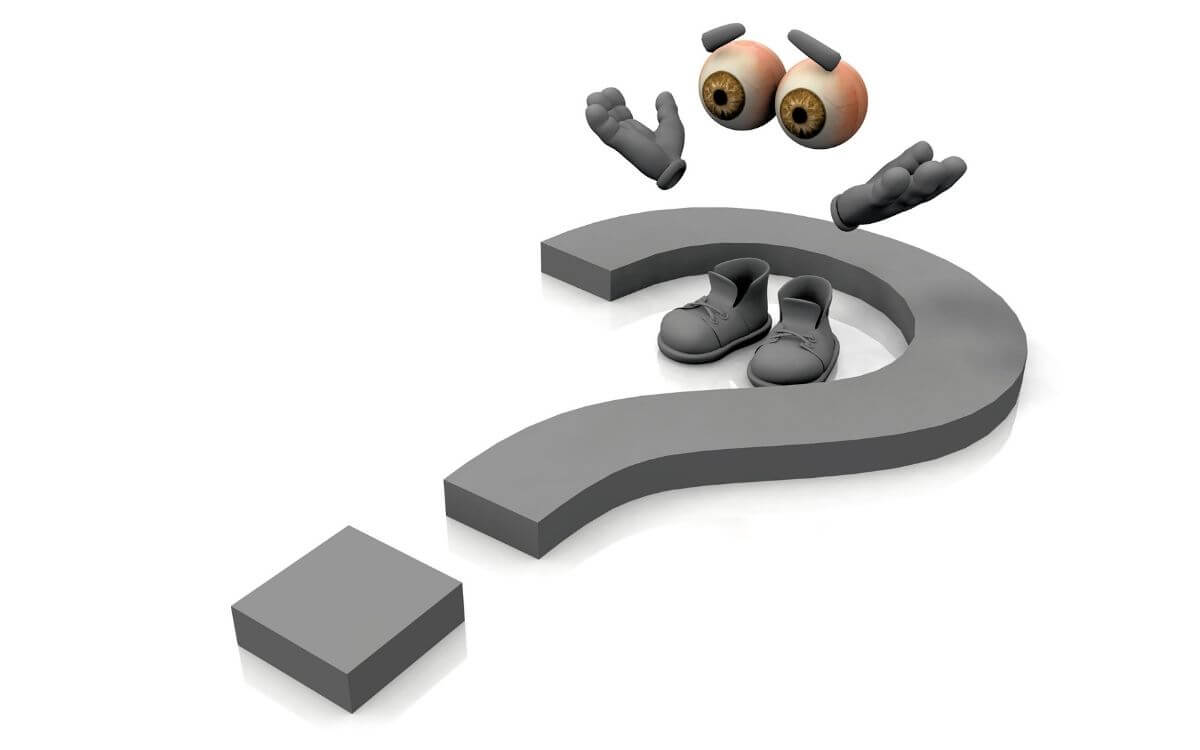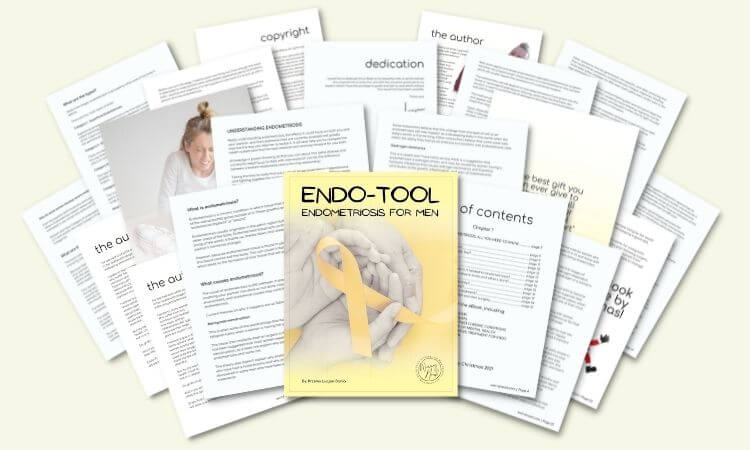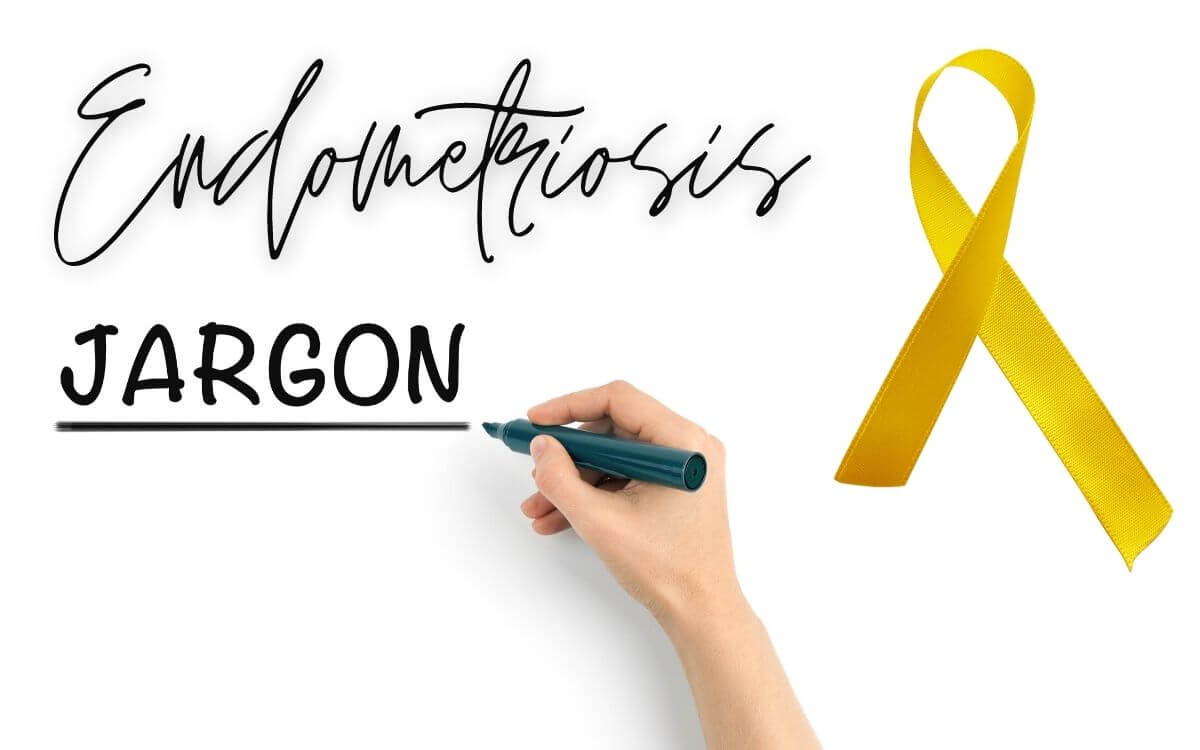Endometriosis jargon for men. Endo what..?
Endometriosis jargon.
I still remember the day when my wife used the word “endometriosis”. It was before she was diagnosed. I didn’t know how to spell it, let alone understand it. Fast forward a decade, today I decided to write this endometriosis jargon for men…
I know that I will never be able to understand what my wife and millions of other women with endometriosis go through. The reason is simple – I’m NOT a woman.
But I wanted to help all my fellow endo-brothers get as close to understanding as it is possible, to get a glimpse of the knowledge that isn’t usually gathered in one place. I collected this endometriosis jargon for men who support their women in battle with endo.
So, this endometriosis jargon for men is for you gents. It explains the most common endometriosis terminology, such as:
- Fetus
- Fibroid
- Follicles
- Gonadotropin-releasing hormone
- Hormone replacement therapy
- Hysterectomy
- Hysteroscopy
- Laparoscope
- Laparoscopic surgery
- Leiomyoma
- Lesion: abnormal tissue
- Luteal phase
- Luteinizing hormone
However, this endometriosis jargon also answers the most common endometriosis questions, including:
- What is endometriosis?
- What causes endometriosis?
- What are the symptoms of endometriosis?
- How to diagnose endometriosis?
- Why endometriosis causes pain?
- How endometriosis affects fertility?
- What is the treatment for endometriosis?
Endo what..?
This section answers the most common endometriosis questions in my endometriosis jargon for men. Let’s begin with the very basics…
What is endometriosis?
Endometriosis is a chronic condition in which the tissue that is similar to the lining of your partner’s womb spreads outside of it, often on other organs. Endometriosis is usually found in the lower abdomen her pelvis, but it can appear anywhere in a women’s body.
What causes endometriosis?
Honestly? No one knows exactly. So far, there are only theories. The most accurate seems to be an excess of estrogen which meant to be, in my understanding, endometriosis building blocks.
When your partner has her period, some of the blood and tissue from her uterus travels into her pelvis. It is called retrograde menstruation. Almost every woman has it to some degree.
These kinds of abnormalities contribute to the development of endometriosis. Other theories exist to explain endometriosis lesions in rare locations outside of the pelvis, which can happen. Researchers actively explore other causes.
What are the symptoms of endometriosis?
The most common symptom of endometriosis is pelvic or lower abdominal pain. This usually happens when your partner has a period, in other words – menstruation. Some women also experience pain with sex.
Other symptoms may include changes in your partner’s bowel and bladder, pain, and fatigue. Symptoms such as pain with her bowel movements, but also bloating, and constipation occurs…
How to diagnose endometriosis?
Definite clinical diagnosis of endometriosis can be made only by laparoscopy – a surgery performed under general anesthesia, in which a doctor looks inside your partner’s abdomen with a camera.
It’s usually done through the belly button and two extra little cuts. A biopsy from a suspected area of endometriosis is taken to confirm the diagnosis.
Why endometriosis causes pain?
When a woman with endometriosis has her period, she bleeds not only from the womb but also from the endometrial tissue outside of the womb. The endometriosis lesions cause inflammation and irritation, which in turn, causes pain.
However, not all women with endometriosis experience pain.
How endometriosis affects fertility?
As many as 40% of women with infertility have endometriosis. Inflammation caused by this condition negatively impacts the function of their ovaries, eggs, fallopian tubes, or the uterus itself.
Endometriosis creates scar tissue that often causes a blockage of the fallopian tubes, which makes it unable to pick up and transport the egg after ovulation.
What is the treatment for endometriosis?
There is NO CURE! My wife found that a holistic, natural approach works best as opposed to medication or hormones. However, treatment for endometriosis depends on the extent of this disease, the degree of symptoms, and the desire for having children in the future.
Endometriosis may be treated with medication, surgery, or both.
The first-line therapy for endometriosis is with medications, but they cause a lot of side effects, which is a problem. Because the endometriosis lesions are sensitive to hormones, lowering estrogen levels may shrink the lesions with a form of progesterone.

Endometriosis jargon for men!
Time to discuss the endometriosis jargon. Prepare for this gentlemen as it’s pretty lengthy. These are the hundred terms that you are going to hear often:
Abdominal hysterectomy – a hysterectomy through the abdominal wall.
Add-back – hormones are given to substitute the hormones lost through other hormone treatments.
Adenomyosis – when endometriosis grows inside the womb’s wall.
Adhesions – Fibrous scar tissues that are formed inside the body.
Aromatase inhibitors – a kind of medication that prevents the enzyme called “aromatase” from working. This enzyme is responsible for a key step in the biosynthesis of estrogens.
Benign – something that is safe, not life-threatening or dangerous.
Biopsy – a tissue sample for tests to confirm the diagnosis of endometriosis.
Bone density – how strong someone’s bones are.
Bowel – a part of the digestive system connecting the stomach and the end of the lower gastrointestinal tract.
Bilateral salpingo-oophorectomy – a surgical procedure to remove ovaries and fallopian tubes.
Bowel resection – a surgical procedure to remove a part of the bowel.
Cauterization – laser removal of tissue.
Cervix – the opening between your partner’s uterus and her vaginal canal.
Chocolate cysts – also called “endometrioma”, an ovarian cyst filled with old, dark blood.
Chronic fatigue syndrome – long-term fatigue which has an impact on day-to-day life.
Cul-de-sac – an area between the womb and the lower gastrointestinal tract.
Cystoscopy – a procedure in which a small telescope is inserted into the urethra to see your partner’s bladder.
Dioxin – a poisonous chemical found in pesticides.
DIE – Deep infiltrating endometriosis.
D&C – also known as “dilatation and curettage”, which is a procedure done under anesthetic, in which the lining of the womb is removed.
Dysmenorrhea – painful periods.
Dyspareunia – painful sex.
Ectopic pregnancy – a pregnancy when a fertilized egg grows inside the fallopian tube.
Endometrial ablation – removal of the womb lining through lasers, heat, and electrical currents. It prevents future childbirth.
Endometrial hyperplasia – a thickening and excessive growth of the womb lining.
Endometrioma – A cyst that contains old menstrual blood which looks like liquid chocolate.
Endometriosis – a female chronic condition.
Endometrium – the mucous membrane that lines the uterus.
Estrogen – it’s the main female sex hormone.
Excision – a surgical procedure that involves cutting out visible areas of endometriosis, usually through laparoscopy.
Fallopian tube – a tube between the ovary and the womb.
Fatigue – extreme tiredness.
Fetus – a young human or animal before birth, after the organs, have started to develop.
Fibroids – benign tumors in the womb.
Follicles – areas in the ovary which contain the egg.
Follicle-stimulating hormone – FSH for short, it’s one of the hormones stimulating the growth of follicles.
Gonadotropins – hormones that control the function of ovaries.
Gonadotropin-releasing hormone – GnRH for short, a hormone controlling the release of gonadotropins from the pituitary gland.
Gynecologist – a doctor specializing in female conditions.
Hormone replacement therapy – HRT for short, it’s a medication that imitates estrogen.
Holistic – natural approach to treatment.
Hysterectomy – a surgery to remove the womb.
Hysteroscopy – it’s an examination of the womb under anesthetic.
In vitro fertilization – commonly known as IVF, it’s fertilization that takes place outside of the womb, in a glass dish.
Infertility – a situation when someone is unable to become pregnant.
Informed consent – the agreement between the patient and a healthcare professional. It means that the patient understands and agrees to her surgery or treatment, and is aware of any risks involved.
Internal exam – a vaginal examination where the doctor puts fingers inside your partner and presses on the abdomen to feel the pelvic organs.
Intrauterine – inside the uterus.
Intrauterine device – a device that is put inside the womb to prevent pregnancy.
Irritable bowel syndrome – commonly known as IBS, which is a bowel disorder causing cramps, bloating, constipation, and diarrhea.
Laparoscope – an instrument used to examine inside the pelvis.
Leiomyoma – simply, fibroids.
Lesion – it’s an abnormal tissue.
Luteal phase – the period of the menstrual cycle between ovulation and menstruation.
Luteinizing hormone – the gonadotropin responsible for releasing the egg.
Laparoscopy – a surgical procedure performed under general anesthetic, in which doctors insert a small telescope into the pelvis through the navel. This is the only method to diagnose endometriosis.
Menopause – when the ovaries stop functioning and your partner’s periods stop.
Menorrhagia – heavy periods.
Menstruation – the monthly cycle in which the womb prepares for pregnancy.
Miscarriage – spontaneous loss of the fetus.
Neurectomy – surgical removal of nerves.
Neuropathic pain – pain caused by damage to the nerves.
NSAIDs – painkillers, such as ibuprofen, that stop the body from producing prostaglandins, which trigger pain in response to disease or injury. Women with endometriosis often produce more prostaglandins.
Obstetrician – a doctor specializing in delivering babies.
Oligomenorrhea – periods that aren’t frequent.
Oophorectomy – it’s the surgical removal of one or both ovaries.
Osteoporosis – a disease where bones become brittle.
Ovaries – the female reproductive organs that produce eggs.
Ovarian cyst – a growth in or on the ovary that is filled with fluid.
Ovarian hyperstimulation syndrome – when the ovaries produce too many follicles, which is often a side effect of fertility treatments.
Ovarian failure – a failure that occurs when the ovaries no longer produce follicles because they are no longer responsive to FSH.
Ovulation – when the ovaries release an egg.
Pelvic inflammatory disease – PID for short, it’s a general term to describe infection in the pelvic area.
Pelvic adhesions – fibrous scar tissues related to previous inflammation often caused by endometriosis, before surgery. They can cause pain.
Pelvic floor therapy – a specific form of physical therapy that addresses the movement and strength of the muscles, bones, ligaments, and fasciae in your pelvis. The goal of this therapy is to prevent or ease the pelvic floor spasms and pain that can occur with endometriosis.
Pituitary gland – the part of the brain that controls hormone function.
Polycystic ovarian syndrome – commonly known as PCOS, a condition in which excessive amounts of the male sex hormone are produced.
Polyps – small growths which can be cancerous or non-cancerous.
Pouch of Douglas – it is the area between the womb and the lower gastrointestinal tract.
Premature menopause – when menopause occurs before the age of 40.
Premature ovarian failure – when the ovaries run out of eggs before menopause.
Presacral neurectomy – when the nerves behind the uterus are cut to reduce pain.
Premenstrual – the time immediately before menstruation and a woman’s behavior and feelings at this time.
Progesterone – it’s a female sex hormone that thickens the uterus lining in order for pregnancy to occur.
Progestogens/progestins – synthetic hormones that behave in a similar way to progesterone.
Prostaglandin – a lipid mediator that helps with muscle relaxation and contraction, cell growth, dilation and constriction of blood vessels, blood pressure, and also inflammation.
Puberty – when the body begins to produce sex hormones.
Rectal – the last few inches of the small intestine.
Reproductive age – it’s the time in which a woman can conceive a child.
Retrograde menstruation – happens when some of the linings of the uterus flow backward during a period into the abdomen.
Salpingectomy – a surgical procedure to remove the fallopian tubes.
Sigmoidoscopy – an investigative procedure in which a telescope is inserted through the back passage and into the colon.
Transvaginal surgery – a kind of surgery that is carried out through the genitals.
Transvaginal scan – an ultrasound carried out through the genitals.
Tumor – a mass of cells that grow inside the body, either benign or cancerous.
Ultrasound – a non-invasive procedure to see inside the body using high-frequency sound waves.
Uterine fibroids – non-cancerous growth that grows within the wall of the uterus.
Uterine polyps – non-cancerous growth that grows from the inner surface of the uterus.
Uterosacral ligaments – the ligaments that hold the uterus in place.
Uterus – commonly known as the womb.
Vaporization – the destruction of endometriosis deposits with lasers.
Womb – known as the uterus.

A glossary of terms…
Learning this glossary of terms will allow you to understand discussions about endometriosis diagnosis, symptoms, and treatments. I wrote this endometriosis jargon for men to help you guys understand endometriosis in the simplest way possible.
I hope I achieved that, and that you will never have to ask again “endo what?”
You are here because your loved one suspects, or was already diagnosed with endometriosis. You are going to be bound to hear many new terms and phrases such as those above, which could be pretty baffling if you didn’t have such endometriosis jargon in one place.
You’d have to look for clues in different places or ask many people. It may seem like you need to learn an entirely new language to make sense of what your partner is going through.
But I hope you don’t have to worry anymore. This endometriosis glossary walks you through the most common medical terminology.
It should be easier for you to understand now what’s being discussed or recommended, so you won’t miss a thing, but if you want to know more about endometriosis use “Endo-Tool, Endometriosis for Men”, an e-Book I wrote to educate men about their partner’s illness, and ways of coping. The 1st chapter is FREE and contains 20 pages filled with a lot of medical info, such as:
- What is endometriosis?
- What are the symptoms?
- What causes endometriosis?
- What does endometriosis look like?
- What are the stages?
- What are the types?
- What is adenomyosis and how is it related to endometriosis?
- Why do some women develop severe endo and others don’t?
- Does endometriosis cause infertility?
- How is endometriosis diagnosed?
- Do types and stages affect the treatment?
- Recurrence of endometriosis after excision surgery.
Get FREE “Endo-Tool”
Endometriosis for Men e-Book

Wishing you and your partner all the very best!


About Me
Hi, I’m Lucjan! The reason why I decided to create this blog was my beautiful wife, who experienced a lot of pain in life, but also the lack of information about endometriosis and fibromyalgia for men...
